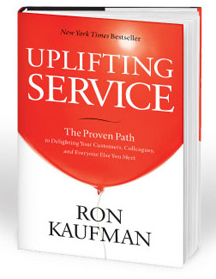Ten tips for effectively handling customer complaints
Dealing with a dissatisfied, disgruntled, impossible-to-please, irrational, and/or irate customer isn't anyone's idea of a good time. Often, customer service providers seek to bring the interaction to a close as quickly as possible, even if it ends on a sour note. But according to Ron Kaufman, it's worth your time and emotional energy to put a little more effort into turning what the customer perceives as a "wrong" into a "right." Handled sensitively, he says, complaints can be a catalyst for improving customer satisfaction and even capturing new business.
 "It's a foregone conclusion that despite your best efforts, some of your customers will be dissatisfied from time to time," notes Kaufman, author of the New York Times bestseller Uplifting Service: The Proven Path to Delighting Your Customers, Colleagues, and Everyone Else You Meet (Evolve Publishing, 2012, ISBN: 978-0-9847625-0-7, $24.95, www.UpliftingService.com). "You have two choices. One, treat the complaining customer like he's a pain in the neck. Or two, appreciate each complaining customer and use the complaint as an opportunity to improve."
"It's a foregone conclusion that despite your best efforts, some of your customers will be dissatisfied from time to time," notes Kaufman, author of the New York Times bestseller Uplifting Service: The Proven Path to Delighting Your Customers, Colleagues, and Everyone Else You Meet (Evolve Publishing, 2012, ISBN: 978-0-9847625-0-7, $24.95, www.UpliftingService.com). "You have two choices. One, treat the complaining customer like he's a pain in the neck. Or two, appreciate each complaining customer and use the complaint as an opportunity to improve."
Kaufman explains that one complaining customer actually represents many other customers who had the same problem, but who didn't complain. (They just badmouthed your company to their friends—or to the entire Internet—and took their business elsewhere.)
"By using a customer complaint to uplift your service, you not only transform that shopper's experience from a negative one to a positive one; you turn him or her into an evangelist for your organization," Kaufman notes. "Furthermore, you gain valuable insight into what many other customers think about your organization, and most importantly, how you can improve your service."
Read on for Kaufman's advice on how to handle customer complaints in a way that will bring satisfaction to everyone involved:
Thank them for their complaint. Give positive recognition by saying, right off the bat, "Thank you for reaching out to let us know how we can improve."
"Show appreciation for the complaining customer's time, effort, communication, feedback, and suggestions," says Kaufman. "Always keep in mind that the customer didn't have to come to you at all. He could have simply taken his business to your competitor. When a customer gives you the opportunity to recover their service, be grateful."
Don't be defensive. It's easy to get defensive when an angry customer is on the other end of the line. Customers with complaints exaggerate situations, they get confused, and yes, they may even lie about how things went down. It's tempting to just say, "No! That's not what happened. You're wrong!" But getting defensive will lead only to more problems.
"When you get defensive, you raise the temperature even higher," notes Kaufman. "Think about the last time you had a disagreement with your spouse. How did it make you feel when he or she told you that you were wrong about something or completely denied that a set of events happened the way you said they happened? Probably not very happy. When a customer complains, they're doing so because they feel wronged in some way. You don't have to agree with what they're saying. But you do have to agree to hear them out. That's how you keep the conversation moving in a positive direction."
Acknowledge what's important to them. Kaufman teaches that service providers must find a complaining customer's value dimension (or what's important to them). Even if you think the customer's complaint is unfair, there is something they value that your company didn't deliver on. Embrace that value.
"What the customer wants is to feel right," explains Kaufman. "When you agree with their value dimension, you're telling them they are right to value this specific thing. For example, if a customer says your service was slow, then that customer values speed. You might say, 'Absolutely, you deserve quick, efficient service.' Or if a customer says your staff was rude, you might say, 'We do agree that you should be treated with courtesy and respect every time you come to our store.'
"When you validate what a customer values, you aren't agreeing with them that your service is slow or that your staff is rude," he adds. "You're saying, 'We agree with you on what you find important and what you value. And we want to deliver in those areas.'" (See tipsheet for scripts on how to respond to customer complaints.)
Use judo, not boxing. In boxing, you go right after your opponent, trying to punch him to the ground. In judo, you work with someone else's motions to create a desired result. You use another person's speed and energy to spin him around and then end up together on the same side.
"When you show a customer you understand what they value, you're catching them off guard with your own movement," explains Kaufman. "They don't expect you to tell them that they're right. Suddenly, just as you might do in judo, you've avoided a defensive confrontation and you can spin them. In judo, you'd spin them to the ground. In customer service, you use the opportunity to show the customer that you're now both on the same side and you can work together."
Explain the company's desire to improve. When you understand what the customer values, show them things your company does that helps you perform well in that area. For example, let's say a customer is complaining because a package was delivered a day late. You would say, "We understand that quick, on-time delivery is important to our customers."
Now the unhappy customer will probably say, "But you failed in my case! My package was a day late." Then, you should calmly say, "Here's what happened. On that day there was a storm that slowed our service. I'd like to reassure you that we are working right now to find a better solution. In fact, we've recently invested $1.7 million in a fleet upgrade that will allow us to better navigate inclement weather and keep our deliveries coming to you on time."
"Show you are sincere about your commitment to do well in the areas the customer values," says Kaufman. "At the very least, you can say, 'I'm going to make sure everyone in the company hears your story. We don't want this to happen again.' When you express the company's desire to improve, you start on the path to rebuilding its credibility with the customer."
Educate your customer. Part of hearing the customer out is answering any questions they ask about their specific situation. Provide additional, useful information. "If they ask a question that you can't answer or don't know the answer to, tell them you'll find out the answer and get back to them," says Kaufman. "And then actually follow through. Contact the customer with the answers they requested. And even if they might not have requested an update about their situation, get back in touch with them with one anyway. These are additional opportunities for you to say through your actions, 'We care about you. We value your business.'"
Contain the problem. Let's say a family is shopping in a crowded, busy department store. The youngest child in the group starts to have an all-out meltdown. Suddenly, a staff member sweeps onto the scene and whisks the family into a special room. Inside, they find bottles of water, snacks, and a comfortable sitting area, etc. The only thing missing in the room is any connection to the store's brand. That's because this room is used to isolate customers from the brand until they're all—parents and children—having a more pleasurable experience. The room is also being used to isolate the unhappy family from the families outside the room who are having a more pleasant shopping experience. And finally, they're being isolated from some staff members who may not be as well prepared to handle these sticky situations.
"That's just one example of how you contain a problem," says Kaufman. "What if the issue isn't a public disruption, but a problem you want to contain before it becomes a public relations disaster? You might instruct your service providers to say something like, 'No matter what our rules or policies are, we see that your circumstance requires flexibility. We want to handle your special situation carefully. Let's work together to figure out what's best. But first, let me thank you for reaching out.' Remember, whatever the situation is, your first order of business is to keep the problem from growing. Only then can you work on defusing it."
Even if you can't help, apologize. Every service provider knows that the customer is not always right. And even when the customer has a point, it's not always within a service provider's power to completely rectify the situation. But the customer is always the customer, and you should apologize for the inconvenience they believe they've experienced.
"For instance, a customer might ask for a retroactive discount on a product that went on sale shortly after the customer purchased it," Kaufman posits. "However, company policy does not allow retroactive discounts. Your service provider might say, 'Unfortunately, it's not our company's policy to give retroactive discounts. [Here, the employee could give a brief explanation of the policy and the reasoning behind it.] However, I understand why you're frustrated, and I apologize.' This response shows understanding and empathy for the customer's discomfort, displeasure, or inconvenience. You might even give your customer service providers leeway to offer freebies or discounts to further defuse situations like these—more on that next."
Recover. Show the customer you care about them, even if you feel the company did everything right, by making them an offer. Companies worry that they'll get taken advantage of if they give vouchers, discounts, or freebies as part of their service recovery, but the reality is that almost never happens.
"Offer the customer something and then explain that you're doing so 'as a gesture of goodwill' or 'as a token of our appreciation,'" says Kaufman. "Sears takes recovery seriously. The company now has a 'blue ribbon team' of specially educated and empowered staff to handle recoveries. Once an issue goes to them, anything they recommend is what gets done. They have full support from the top down. Sears does this because the company understands that a successfully recovered customer can become your most loyal advocate and ally."
Give serial complainers an out. Some people just love to complain. These kinds of customers complain, not so that they can become satisfied, but because they are never satisfied. With serial complainers, you must limit your liability and isolate them from your brand.
"These are the people who gripe that your company's free-with-purchase giveaway is too 'cheap,' for instance, or who personally attack employees for not doing what they want, even though the company policy has already been politely explained to them multiple times," Kaufman notes. "Serial complainers are an especially strong drain on your employees, so it's important not to let them run roughshod over your customer service providers once they've proven that they don't want to be helped.
"To handle serial complainers, keep your wits about you," he instructs. "Don't let their lack of manners bring your manners down. Don't let their bad mood infect yours. And in advance, work out with your colleagues when and how to support each other when a serial complainer shows up. Being served by you in tandem with a colleague or two will cause many serial complainers to back down or at least calm down. Finally, just before the complainer departs, let them know you are genuine about welcoming them back and wanting them to be happy. Most people—including serial complainers—will reflect on their behavior later in the day and feel awkward or even ashamed. You want their final memory of you to be powerful and positive."
"Your customers are not your enemy," says Kaufman. "It's sometimes hard to remember that when you're involved in a tense complaint situation. But they're essential to your business and you really are both on the same side. Your customer wants the product or service you provide, and you want to give it to them. When you treat complaints as opportunities to build loyalty, you can create customers for life and uplift your entire company in the process."
 Ron Kaufman, UP! Your Service founder and chairman, believes service is the essence of humanity. He has helped companies on every continent build a culture of uplifting service that delivers real business results year after year. He is the author of the New York Times bestseller Uplifting Service and 14 other books on service, business, and inspiration. UP! Your Service enables organizations to quickly upgrade service performance and secure a sustainable advantage by building an uplifting service culture. To learn more about UP! Your Service, please visit www.UpYourService.com. To learn more about Ron Kaufman, please visit www.RonKaufman.com.
Ron Kaufman, UP! Your Service founder and chairman, believes service is the essence of humanity. He has helped companies on every continent build a culture of uplifting service that delivers real business results year after year. He is the author of the New York Times bestseller Uplifting Service and 14 other books on service, business, and inspiration. UP! Your Service enables organizations to quickly upgrade service performance and secure a sustainable advantage by building an uplifting service culture. To learn more about UP! Your Service, please visit www.UpYourService.com. To learn more about Ron Kaufman, please visit www.RonKaufman.com.
Tipsheet:
Say What? Five Quick Responses to Customer Complaints
By Ron Kaufman, author of the New York Times bestseller Uplifting Service: The Proven Path to Delighting Your Customers, Colleagues, and Everyone Else You Meet (Evolve Publishing, 2012, ISBN: 978-0-9847625-0-7, $24.95, www.UpliftingService.com)
The last thing a stressed, dissatisfied customer wants to hear you say is: "You're wrong." What they want to hear is that you understand them, appreciate them, and agree with them on the importance of the value they have cited in their complaint.
Here are a few quick scripts to use when responding to customer complaints:
Customer Complaint: Rude Service
Your customer says: "Your staff was rude and totally unprofessional."
You say: "You are right to expect courteous, respectful, and professional staff."
Customer Complaint: Too Many Rules
Your customer says: "Your policies are rigid. Your company is so bureaucratic."
You say: "I agree that we should be as flexible and user-friendly as possible. Your suggestions can really help."
Customer Complaint: Overpriced
Your customer says: "This product isn't anything like what I was promised. And your price is way too high!"
You say: "I am on your side in this situation. You have a right to be satisfied with whatever you purchase from us. You deserve good value for your money. Let's review what you have purchased and see if there's a better option for you."
Customer Complaint: Too Slow
Your customer says: "I've been waiting forever. Why did it take you so long to take my order?"
You say: "We understand that in today's world speed counts. You deserve fast, friendly service."
Customer Complaint: Bad Website
Your customer says: "Your website is terrible. I couldn't find the information I needed."
You say: "You are right to want an informative, user-friendly website. What information couldn't you find? Your suggestions on how to improve the site are a big help."
Notice how your responses make the customer feel right. We don't argue over the facts: rude staff, stiff policies, or insufficient product features. But we do actively agree on the importance of what they value most.
Let's face it—the customer is not always right. But customers are always important. We can make them feel much better by agreeing with them on the importance of the service dimensions they identify and value.











